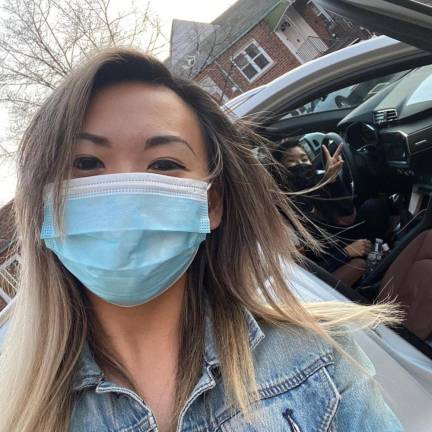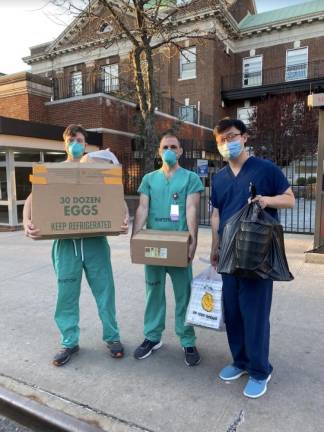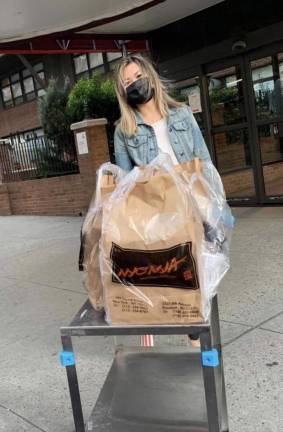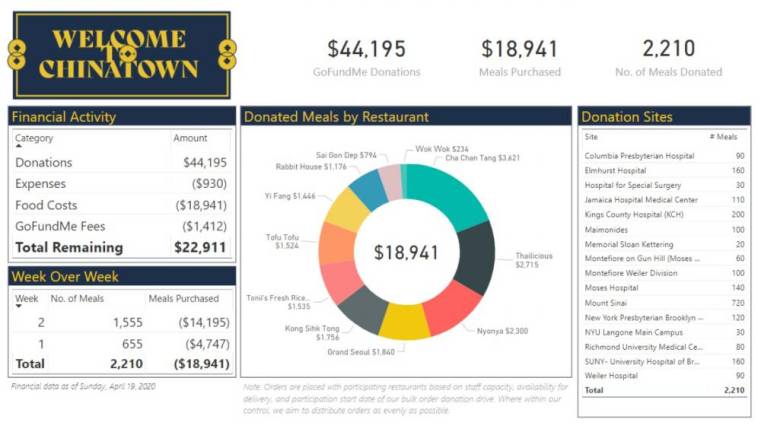On a Mission to Save Chinatown
Welcome to Chinatown delivers over two thousand meals to essential workers at NYC hospitals




Manhattan today is so different than it was just two months ago. Bursting neon lights have been replaced by shuttered businesses, the cacophony of voices has long been silenced and congested streets once brimming with energy are now desolate. While all of the city is struggling amid the COVID-19 crisis, among the hardest hit by the virus economically and socially is Chinatown.
“It kind of feels like we’re living in a movie,” said Jennifer Tam, who works in corporate communications at Foursquare.
The unfortunate truth is, this is not a movie. This is Chinatown’s bleak reality. The decline began in January, around the Chinese New Year, as the coronavirus gained traction in the American news media and it was announced that the virus originated in Wuhan, China. President Trump’s referral to COVID-19 as the “Chinese virus” only heightened xenophobia.
“I think Chinatown was the first to suffer because of the racist connotations associated with the virus coming from China,” said Alice Wong, the Chief of Staff at the Chinese-American Planning Council (CPC), a nonprofit organization that offers services to Chinese-American, immigrant, and low-income community members.
Since mid-February, Chinatown business owners have reported a decrease in sales between 30 to 80 percent, according to CNN. Victoria Lee, a corporate travel and meetings strategist at The Estée Lauder Companies who is a long-time friend of Tam’s, said she believes that currently the decline is upwards of 80 percent.
Tam and Lee both live in Chinatown and saw the deterioration of their neighborhood firsthand. The consequences of coronavirus became so severe that before the in-restaurant dining ban, one Friday night the pair were the only patrons at Wo Hop, usually known for having a line out the door. It was then that they devised a plan to help Chinatown restaurants.
Crowdsourcing Funds
The result was Welcome to Chinatown, a grassroots initiative that acts as an advocate for neighborhood restaurants and strives to keep them financially afloat. It officially launched on March 21 and originally, the duo set out to sell gift cards. “A lot of these Chinatown businesses are cash only, they don’t even have a digital POS [point of sale] system,” said Lee. Business owners were also skeptical of the pair’s motives. “They didn’t know our faces and our Cantonese is not good.”
Instead, they opted for crowdsourcing funds through a GoFundMe, where donations would be gathered throughout the week. Next, a group of 14 Welcome to Chinatown volunteers reached out to hospitals such as Mount Sinai or Elmhurst Hospital, and asked if they accept meal donations for essential workers. If the hospital accepts donations, bulk orders are placed with at 12 of the 46 restaurants they represent. (For the other restaurants who aren't receiving bulk orders, Welcome to Chinatown offers support in marketing/branding and business management needs.) A person from TaskRabbit delivers the meals. There is not an exact science to ensuring that the bulk orders are distributed evenly among restaurants, but the group tries their best.
“There’s a lot of factors that go into it, if they have enough bandwidth or ingredients to fulfill for that day," said Tan, "but we’ve been able to generally keep an even distribution of orders across our participating restaurants.”
So far, Welcome to Chinatown has raised $63,000 and donated over 2,000 meals to 19 hospitals. It’s a win-win for essential workers who are being fed a free meal. And for some Chinatown restaurants, the bulk orders are the only thing keeping them open.
“Without Welcome to Chinatown it’s been very, very difficult,” said Yoshiko Sakuma, owner of the Omakase and Japanese bar Rabbit House on Essex Street. “We are not the type of restaurant for deliveries, so we have been able to put together specialty boxes for the hospitals.”
Public Support
Despite being open for takeout and delivery during stay-at-home orders, Sakuma admits that the majority of the sales from last week have come from the Welcome to Chinatown bulk orders. She is not alone. Tonii’s Fresh Rice Noodle on Bayard Street was on the cusp of permanently closing their doors until the bulk orders were placed, Tam explains.
In the first week of operation, Welcome to Chinatown served 635 orders, but by the second week the number of meals served jumped to 1,555. This week they predict they will serve around 1,000 meals to New York City hospitals. It’s a lot of work, but Lee and Tam are modest saying that balancing full-time jobs and coordinating a large-scale initiative was “not difficult, just a lot of back and forth communication.” The gratitude that comes from restaurant owners is what keeps them going.
“In one catering order, we’re giving them in a day what they’ve been making in a week,” said Lee.
Despite the hard work and public support, the neighborhood’s past indicates that the effects of coronavirus will remain even after the restaurants are allowed to open again. “Chinatown, particularly in Manhattan is always the last to recover,” said Wong, citing slow recovery periods following 9/11.
Welcome to Chinatown’s business model relies on the goodwill of individuals and monetary donations. But right now, more than ever, the organization feels it is imperative to spread the word to save this vibrant and important neighborhood. When Tam reflects on the significant impact of the volunteers, donations and advocacy that they have already made, she is positive.
“It really is a testament to how many people love the neighborhood and how much Chinatown means to a lot of people.”
"Without Welcome to Chinatown it’s been very, very difficult.” Yoshiko Sakuma, owner of Rabbit House